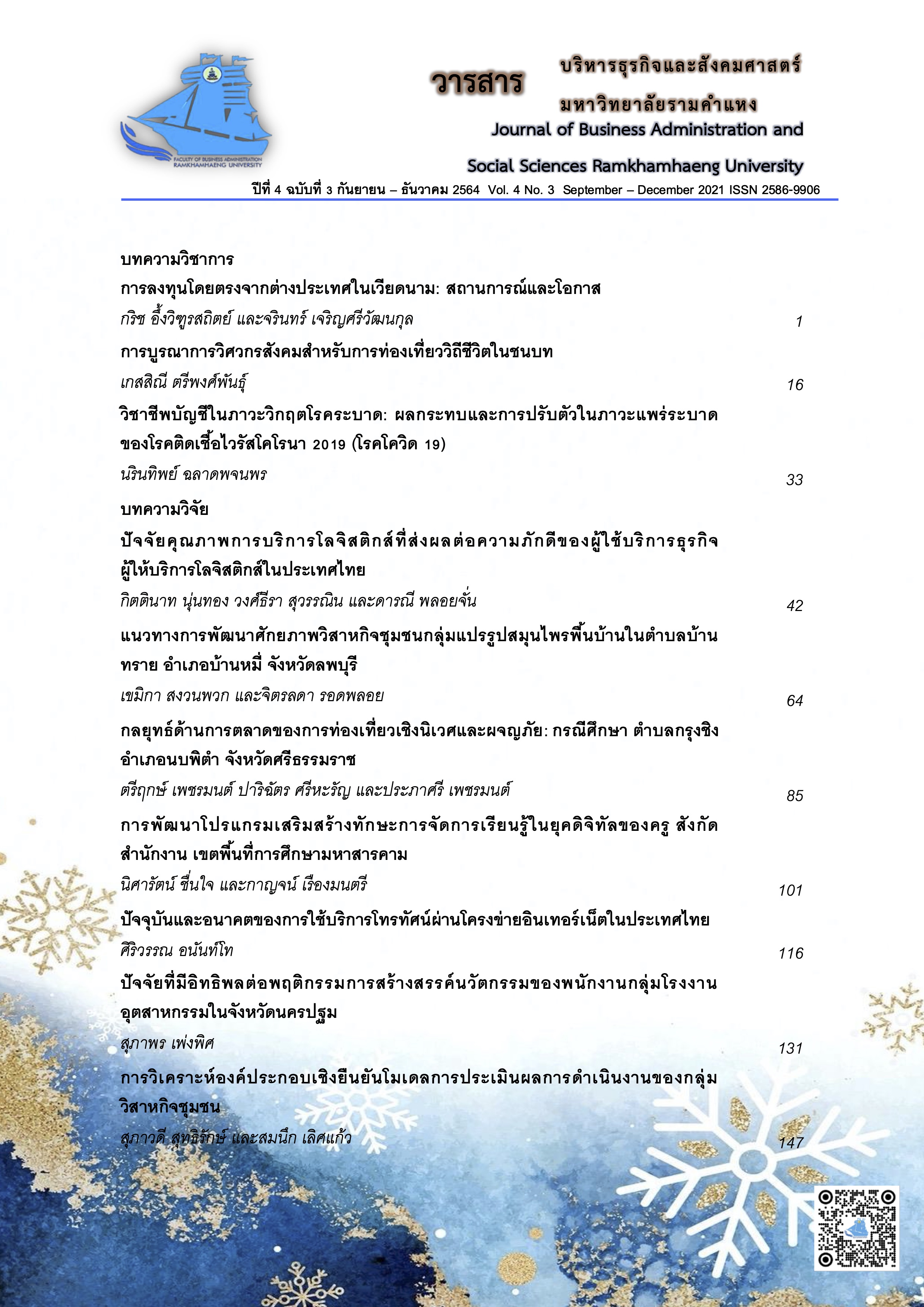Current Status and Future Prospects of OTT Service in Thailand
Main Article Content
Abstract
OTT or Over-the-Top is the provision of broadcasting services or television through the Internet networks instead of traditional broadcasting and television. This is a key factor in broadcasting services and the contents of various programs through the Internet without having to invest in their own network infrastructure. In this qualitative research, the researcher studies the current status and future prospects of OTT in Thailand. Data were collected through document reviews and in-depth interviews with key informants using the techniques of purposive and network sampling consisting of twenty-two OTT service providers, broadcasters, academics, and related experts. Data were analyzed using the technique of qualitative content analysis.
Findings showed that the behavior of young viewers has changed from viewing in accordance with the program layouts to be increasingly viewing back up online contents and on demand. The OTT market in Thailand has grown continuously. This affects free TV and pay TV operators. The traditional business model has also changed. However, OTT is considered a new opportunity and a channel to access viewers as well as to expand the business revenue of TV operators in various ways. In the future, OTT will grow increasingly because its services respond well to the new generations. Supportive factors are in the aspect of basic infrastructure and change in demography in the future. The public sector should monitor for fair competition. A national plan should be prepared to foster cooperation in promoting and developing the program contents of OTT in order to ensure that Thai programs can compete at an international level.
Article Details
เนื้อหาและข้อมูลในบทความที่ลงตีพิมพ์ในวารสารบริหารธุรกิจและสังคมศาสตร์ มหาวิทยาลัยรามคำแหง ถือเป็นข้อคิดเห็นและความรับผิดชอบของผู้เขียนบทความโดยตรง ซึ่งกองบรรณาธิการไม่จำเป็นต้องเห็นด้วย หรือร่วมรับผิดชอบใดๆ
บทความ ข้อมูล เนื้อหา รูปภาพ ฯลฯ ที่ได้รับการตีพิมพ์ในวารสารบริหารธุรกิจและสังคมศาสตร์ มหาวิทยาลัยรามคำแหง ถือเป็นลิขสิทธิ์ของวารสารบริหารธุรกิจและสังคมศาสตร์ มหาวิทยาลัยรามคำแหง หากบุคคลหรือหน่วยงานใดต้องการนำบทความทั้งหมดหรือส่วนหนึ่งส่วนใดไปเผยแพร่ต่อ หรือเพื่อกระทำการใดๆ จะต้องได้รับอนุญาตเป็นลายลักษณ์อักษรจากวารสารบริหารธุรกิจและสังคมศาสตร์ มหาวิทยาลัยรามคำแหง ก่อนเท่านั้น
References
มหาวิทยาลัยสุโขทัยธรรมาธิราช (2564). รายงานสรุปผลการวิจัยโครงการศึกษาพฤติกรรมและความ
ต้องการของประชาชนในการใช้บริการโทรทัศน์ในยุคภูมิทัศน์สื่อใหม่. สำนักงานคณะกรรมการ
กิจการกระจายเสียง กิจการโทรทัศน์ และกิจการโทรคมนาคมแห่งชาติ.
ศูนย์บริการวิชาการแห่งจุฬาลงกรณ์มหาวิทยาลัย. (2563). การศึกษาผลกระทบของ OTT ต่อกิจการ
กระจายเสียง และกิจการโทรทัศน์ และแนวทางการส่งเสริมและกำกับดูแล. สำนักงานคณะกรรมการกิจการกระจายเสียง กิจการโทรทัศน์ และกิจการโทรคมนาคมแห่งชาติ.
สำนักงาน กสทช. (2560ก). สภาพการแข่งขันและแนวทางการกำกับดูแลกิจการ Over The Top: OTT.
สืบค้นจาก http://202.125.84.14/data/academic/file/600900000004.pdf
สำนักงาน กสทช. (23 มิถุนายน. 2560ข). สรุปเนื้อหาการประชุมเพื่อเตรียมความพร้อมในการเป็นผู้
ให้บริการกระจายเสียงหรือโทรทัศน์ OTT. โดย พันเอก ดร. นที ศุกลรัตน์ ในการประชุมคณะกรรมการกิจการกระจายเสียงและกิจการโทรทัศน์ (กสท.) ครั้งที่ 16/2560 เมื่อวันจันทร์ที่ 12 มิถุนายน 2560.
สำนักงานพัฒนาธุรกรรมทางอิเล็กทรอนิกส์ (ETDA). (2563). รายงานผลการสำรวจพฤติกรรมผู้ใช้
อินเทอร์เน็ตในประเทศไทย ปี 2563.
TIME Consulting. (25 มกราคม 2560). โครงการศึกษาแนวทางการกำกับดูแลการแข่งขันในกิจการ
โทรทัศน์แบบ Over the Top (Competition Regulation on OTT TV). สำนักงานคณะกรรมการ
กิจการกระจายเสียง กิจการโทรทัศน์ และกิจการโทรคมนาคมแห่งชาติ.
Adobe & The Diffusion Group (TDG). (April 27, 2016). Consumers Spend 42% of Big Screen TV Time Viewing OTT. Retrieved May 1, 2021 from https://www.thebroadcastbridge.com/content/entry/5782/consumers-spend-42-of-big-screen-tv-time-viewing-ott.
CONC, Thammasat Business School. (2018). Online Video Study in Thailand. Asia Internet Coalition.
Dimmick, J., Feaster, J. C., & Ramirez, A. (2011). The niches of interpersonal media:
Relationships in space and time. New Media & Society, 13(8), 1265–1282. doi:10.1177/
Friedman, T. (1999). The Lexus and the olive tree. New York: Farrar, Straus & Giroux.
Haniff, Z. (2012). Niche theory in new media: Is digital overtaking the print magazine industry?
UNLV Theses, Dissertations, Professional Papers, and Capstones 1571.
Inplayer. (2017). Habits and generational gap of OTT subscribers. Retrieved from https://inplayer.
com/habits-and-generational-gap-of-ott-subscribers.
Katz, E. (1959). Mass Communications Research and the Study of Popular Culture: An Editorial
Note on a Possible Future for this Journal. Studies in Public Communication, 2, 1-6.
Retrieved from https://repository.upenn.edu/asc_papers/165.
KBV Research. (2020). Over the top (OTT) services market size. Retrieved from https://www.
kbvresearch.com/over-the-top-services-market.
Lehman-Wilzig, S. & Cohen-Avigdo, N. (2004). The natural life cycle of new media evolution.
New Media & Society, 6(6), 707-730.
Palmgreen, P., & Rayburn, J. D. (1985). A comparison of gratification models of media
satisfaction. Communication Monographs, 52(4), 334-346. https://doi.org/10.1080/03637758509376116.
Ovum. (2019). OTT Media Services Consumer Survey & OTT-CSP Partnership Study. Statista
Advertising and Media Outlook. (2021). Revenue of OTT video in Thailand from 2017 to 2025. Retrieved from https://www.statista.com/forecasts/1256808/ott-video-services-revenue-thailand.
Statista. (2021). Advertising & media outlook. Retrieved from https://www.statista.com/outlook/amo/media/tv-video/ott-video/thailand
Thammasat Consulting Networking and Coaching Center (CONC) (2021). Online Video Study in Thailand.
The Broadcast Bridge. (2021). Distribution & Delivery. Consumers Spend 42% of Big Screen TV
Time Viewing OTT. Retrieved from
https://www.thebroadcastbridge.com/content/ entry/5782/consumers-spend-42-of-big-
screen-tv-time-viewing-ott.2015.
We Are Social. (January 2021). Digital 2021: Global Overview Report. Retrieved from https://wearesocial.com/blog/2021/01/digital-2021-the-latest-insights-into-the-state-of-digital.
_____________. (April 2021). Digital 2021 Report (April Update). Retrieved from https://www.hootsuite.com/resources/digital-trends-q2-update.


